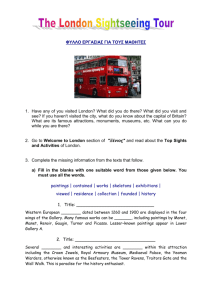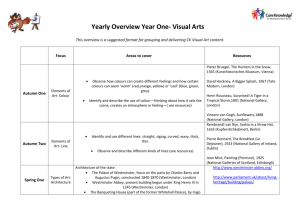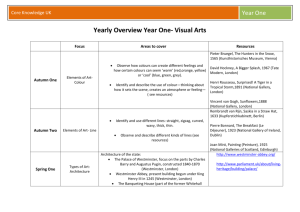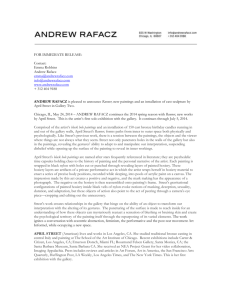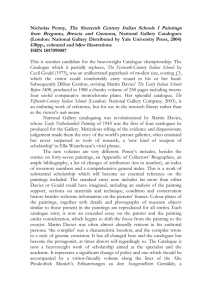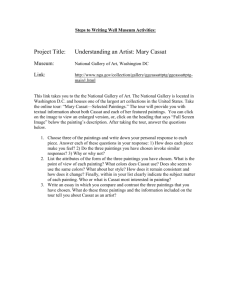Secrets and Skies
advertisement
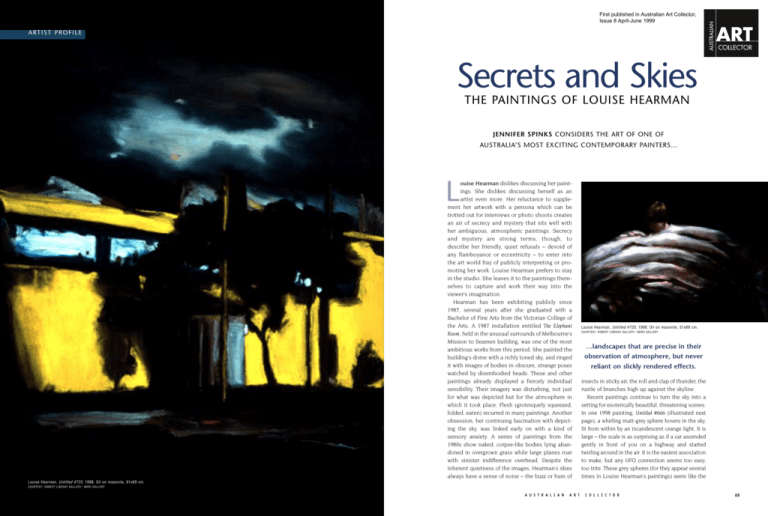
First published in Australian Art Collector, Issue 8 April-June 1999 ARTIST PROFILE Secrets and Skies THE PAINTINGS OF LOUISE HEARMAN JENNIFER SPINKS CONSIDERS THE ART OF ONE OF AUSTRALIA’S MOST EXCITING CONTEMPORARY PAINTERS… L ouise Hearman dislikes discussing her paintings. She dislikes discussing herself as an artist even more. Her reluctance to supplement her artwork with a persona which can be trotted out for interviews or photo shoots creates an air of secrecy and mystery that sits well with her ambiguous, atmospheric paintings. Secrecy and mystery are strong terms, though, to describe her friendly, quiet refusals – devoid of any flamboyance or eccentricity – to enter into the art world fray of publicly interpreting or promoting her work. Louise Hearman prefers to stay in the studio. She leaves it to the paintings themselves to capture and work their way into the viewer’s imagination. Hearman has been exhibiting publicly since 1987, several years after she graduated with a Bachelor of Fine Arts from the Victorian College of the Arts. A 1987 installation entitled The Elephant Room, held in the unusual surrounds of Melbourne’s Mission to Seamen building, was one of the most ambitious works from this period. She painted the building’s dome with a richly toned sky, and ringed it with images of bodies in obscure, strange poses watched by disembodied heads. These and other paintings already displayed a fiercely individual sensibility. Their imagery was disturbing, not just for what was depicted but for the atmosphere in which it took place. Flesh (grotesquely squeezed, folded, eaten) recurred in many paintings. Another obsession, her continuing fascination with depicting the sky, was linked early on with a kind of sensory anxiety. A series of paintings from the 1980s show naked, corpse-like bodies lying abandoned in overgrown grass while large planes roar with sinister indifference overhead. Despite the inherent quietness of the images, Hearman’s skies always have a sense of noise – the buzz or hum of Louise Hearman, Untitled #725, 1998. Oil on masonite, 51x69 cm. COURTESY: ROBERT LINDSAY GALLERY / MORI GALLERY …landscapes that are precise in their observation of atmosphere, but never reliant on slickly rendered effects. insects in sticky air, the roll and clap of thunder, the rustle of branches high up against the skyline. Recent paintings continue to turn the sky into a setting for esoterically beautiful, threatening scenes. In one 1998 painting, Untitled #666 (illustrated next page), a whirling matt-grey sphere hovers in the sky, lit from within by an incandescent orange light. It is large – the scale is as surprising as if a car ascended gently in front of you on a highway and started twirling around in the air. It is the easiest association to make, but any UFO connection seems too easy, too trite. These grey spheres (for they appear several times in Louise Hearman’s paintings) seem like the Louise Hearman, Untitled #723, 1998. Oil on masonite, 91x69 cm. COURTESY: ROBERT LINDSAY GALLERY / MORI GALLERY A U S T R A L I A N A R T C O L L E C T O R 69 First published in Australian Art Collector, Issue 8 April-June 1999 Hearman has a speculative interest in what the planet might be like if it were utterly transformed. Now Hear This… ANDREW G FROST PROFILES THE SHORT BUT IMPRESSIVE CAREER OF LOUISE HEARMAN… ing glow; clouds gathered in banks that loom low, not allowing heat to escape and generating a sense of thickness in the air; banks of cloud that form a dense, thick surface for the play of light. They block the light to create dramatic chiaroscuro, bouncing it back into the scene to illuminate trees and creatures and water in subtle or flaming hues. Hearman has the kind of fascination with the drama of natural phenomena – especially the night sky – that can see her driving into the country at 3am to get a better view of a comet shower. This kind of attentive, curious looking translates into landscapes that are precise in their observation of atmosphere, but never reliant on slickly rendered effects. The strangeness of Hearman’s imagery is not just located in the juxtaposition of unlikely elements (such as an unidentifiable sphere spinning above a country road). The complexity and subtlety of these paintings is located not only in what they depict, but in the way that they are made. As an analogy, photographic superimposition, which makes the images on layered negatives exist in the same Louise Hearman, Untitled #666, 1998. Oil on masonite, 91x69 cm. COURTESY: ROBERT LINDSAY GALLERY / MORI GALLERY spatial plane and light source, is air has gathered in on itself and turned to anti-matter – a disinalmost right. Yet it doesn’t quite account for the density of terested, self-absorbed, unknowable threat. atmosphere that builds up between the disparate elements in The sphere hovers above an ordinary road – unsealed, narrow, Hearman’s works; the way that brush strokes both delineate and and surrounded on either side by trees. It is located in the kind blur to place things inside a shimmering or shadowed haze. This of Australian bush that is instantly recognisable, verdantly haze does not exactly suppress detail, but it does make the green but overlaid with silvery-blueish-brown highlights of dust edges and structures of these scenes seem unreal. and a haze of golden light. Strips of shadow run across the road, In many of Hearman’s paintings a figure appears to be hoverjoining up with dark tree trunks and creating a formal structure ing across the horizon line: inescapably in the field of vision, which binds the image together. Hearman returns repeatedly to inexplicably in the wrong place. The scale is always strange and this kind of blue and green Australian bush. It has a luminous, arresting. In one recent work, the head and shoulders of a pershimmering depth of colour, as well as an air of potential transson uncannily echoes the form, the density and the brooding formation, that strangely recalls the work of Norman Lindsay. atmospheric quality of the trees that the figure emerges from. This depth and richness of tone and colour is emphasised by Rather than the juxtaposition of a gigantic figure with a quiet the times of day – dusk and early evening – that the paintings bush skyline, these elements are so similar, so quietly harmogenerally conjure. They often recall the kinds of days when storm nious, that, unexpectedly, it is their weird congruence that is the clouds have built up and are casting a strange, colour-intensifymost striking aspect of the painting. 70 A U S T R A L I A N A R T C O L L E C T O R L ouise Hearman, 36, made her debut in the Australian art world with a critically acclaimed installation in Melbourne’s Mission to Seamen building in 1987. Putting to use the existing domed space and painting directly onto the walls and roof, Hearman’s bold use of figurative elements and her rich, impressive brushwork drew immediate praise from critics and collectors alike. She made her Sydney debut at the Mori Gallery the same year. For more than 10 years Hearman has remained faithful to her vision, producing a body of work that has earned her a place among the rising stars of contemporary painting. With her work commanding prices from $650 up to $5,000, and a steady flow of critical and institutional support, Hearman has seen her work acquired by some of the country’s leading public collections, including the National Gallery of Victoria and the National Gallery of Australia, and Artbank as well as major corporate collections like those of Shell and Allen, Allen and Helmsley. When Melbourne gallerist Robert Lindsay was establishing his highly respected Flinders Lane Gallery in 1994, Hearman was on his shortlist of ‘must-haves’ for the new exhibition space. Hearman has exhibited with the Robert Lindsay Gallery since it opened. “I’d known her work from the time when I was the senior curator of contemporary art at the NGV,” Lindsay told AAC. “I was quite familiar with the artists who were showing in Melbourne. Louise was one who had been around and had had a number of very interesting shows.” What was it about Hearman’s work that attracted Lindsay? “Aside from her obvious technical expertise, Louise was actually talking about something that was very particular to her. The work was idiosyncratic and it was an interesting insight into Louise as a person. But she was also looking at the more romantic side of art. It was an area of painting that, at that time, was producing a number of interesting artists.” Lindsay succinctly summarises the attraction of Hearman’s work, attributing much of its appeal to her use of figuration. “I’d say (the work’s) appeal comes through three things,” observes Lindsay. “First, there is the empathetic reading of the figurative story that’s happening in her work – the symbolism. Secondly, there is a genuine admiration and enthusiasm for her technical expertise and, thirdly, there’s a strong emotional impact with the ‘enigma’ and intrigues of the imagery.” Lindsay continues, “Louise’s work talks on that immediate, empathetic, emotional level. When you’re dealing with abstraction, it’s a much more rarefied communication. When you look at figurative images like those in Louise’s paintings, which are using archetypes of our society, you don’t need any prior knowledge. Her work actually talks about the social context you’re living in as well.” n A U S T R A L I A N A R T C O L L E C T O R 71 First published in Australian Art Collector, Issue 8 April-June 1999 Her images are intrinsically secretive – one more reason why we find them so desirable and unsettling. Louise Hearman, Untitled #475, 1998. Oil on masonite, 54x69 cm. Another 1998 painting depicts the head of an animal which hangs in the air in front of what is apparently an ordinary suburban house. It looks like a monkey, or perhaps a cat with its ears obscurely effaced. While its genealogy may be the garrulous, joke-telling Cheshire cat, it has an intelligent, knowing, yet mute quality. Like the figure in the previous painting, it is its simple presence that warns us that we are stepping into another world. Like Carroll’s Wonderland, the work depicts a place that looks uncannily like the world with which we are already familiar, but perversely follows none of its rules. Like many of us, Hearman has a speculative interest in what the planet might be like if it were utterly transformed (by war, natural disaster, even the Y2K bug). It is appropriate that her paintings hint at a place which is not physically altered, yet has been changed utterly in the way that it is looked at and experi- 72 A U S T R A L I A N COURTESY: ROBERT LINDSAY GALLERY / MORI GALLERY enced and understood. The mysterious, silent figures that occupy these worlds appear as apparitions which could be either supernatural or perceptual: ghostly creatures, or the effects of light multiplied and transformed in a sideways glance. Either way, they have a vision-like force. While things are only hinted at, alluded to, and mutely gestured toward in Hearman’s paintings, their withholding of information is never coy. They are direct in their evocation of place, of sensory impressions, of feelings that are tangible without being explicable, and of objects that have a sensual immediacy. It is banal to suggest that artists make images of that which cannot be said. Yet when Louise Hearman refuses to elaborate on the meanings of her paintings she is simply acting in accordance with their mysterious nature. These images are intrinsically secretive – one more reason why we find them so desirable and unsettling. n A R T C O L L E C T O R
